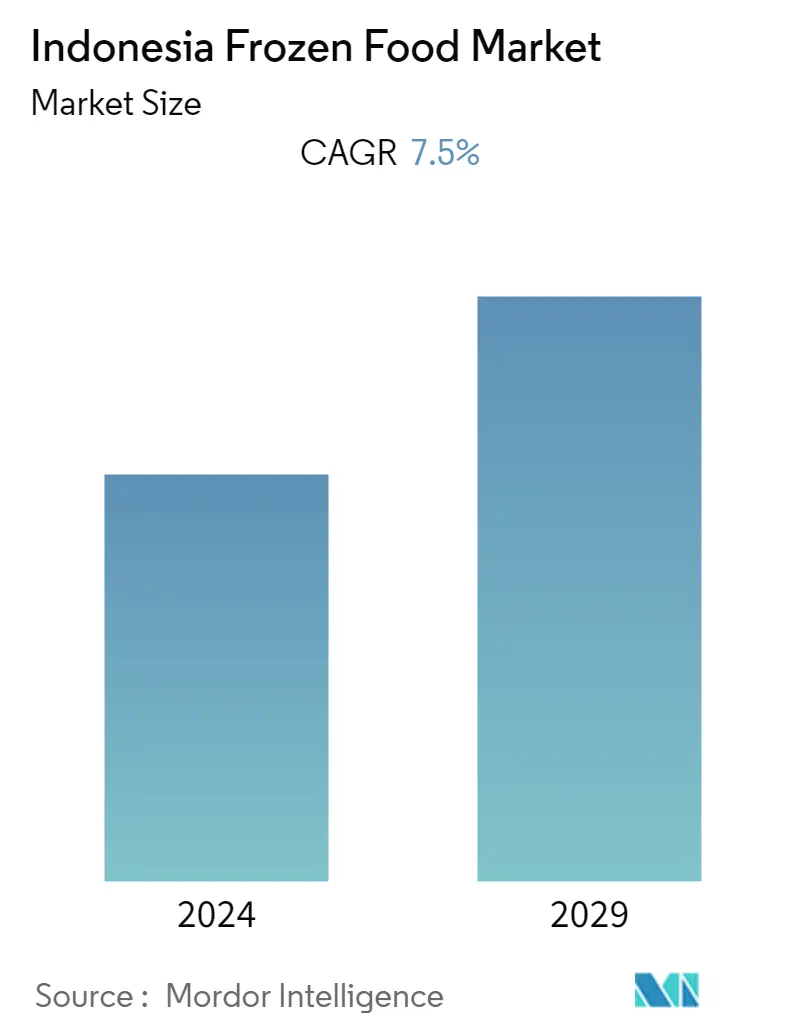Market Size of Indonesia Frozen Food Industry

| Study Period | 2019 - 2029 |
| Base Year For Estimation | 2023 |
| Forecast Data Period | 2024 - 2029 |
| Historical Data Period | 2019 - 2022 |
| CAGR | 7.50 % |
| Market Concentration | High |
Major Players.webp)
*Disclaimer: Major Players sorted in no particular order |
Indonesia Frozen Food Market Analysis
The Indonesian frozen food market is expected to grow from USD 1.93 billion in 2023 to USD 2.78 billion by 2028, registering a CAGR of 7.50% during the forecast period (2023-2028).
Indonesia is witnessing a surge in the number of nuclear families. According to Statistics Indonesia, 39.16% of households in Indonesia consisted of 2-3 family members as of 2022. These families are typically more liberal with spending and are driving the premiumization trends in the FMCG sector. Moreover, the increasing workforce participation and the busy lifestyle of individuals are changing the dietary patterns of consumers, which involve consuming quick and healthier meals. This, in turn, drives the retail sales of frozen food products that are convenient and easy to cook. In addition, the proliferation of value-added products in the country is a testament to consumers' need for practical and convenient products. For instance, according to the USDA Foreign Agricultural Service, in 2021, the retail sales value of packaged food in Indonesia amounted to 32,967 USD million. Besides this, international players in the frozen food segment are adopting innovative strategies such as expansion, merger and acquisition, and product launches to gain a prominent market share. For instance, in January 2022, Yili Group, a Chinese producer of dairy products, announced its expansion with the launch of its facility in Indonesia. The company claimed that the facility was established due to the popularity of Joyday Ice Cream in the country. This brand has rapidly expanded to 260 local cities in 26 provinces, covering nearly all of Indonesia, since its entry into the market in 2018.
Indonesia Frozen Food Industry Segmentation
Frozen food products are complete meals or portions of meals that are precooked, assembled into a package, and frozen for retail sale. They are popular among consumers as they provide a diverse menu and are convenient to prepare.
The market studied is segmented by type and distribution channel. Based on type, the market is segmented into frozen fruits and vegetables, frozen ready meals, frozen processed meat products, frozen processed seafood, frozen bakery products, and other types. Based on distribution channels, the market is segmented into hypermarkets and supermarkets, grocery stores and convenience stores, and online retail stores. The market sizing has been done in value terms in USD for all the above-mentioned segments.
| By Type | |
| Frozen Fruits and Vegetables | |
| Frozen Ready Meals | |
| Frozen Processed Meat Products | |
| Frozen Processed SeaFood | |
| Frozen Bakery Products | |
| Other Types |
| By Distribution Channel | |
| Hypermarkets/Supermarkets | |
| Grocery Stores/ Convenience Stores | |
| Online Retail Stores |
Indonesia Frozen Food Market Size Summary
The Indonesian frozen food market is experiencing significant growth, driven by changing consumer lifestyles and preferences. The rise in nuclear families and increased workforce participation have led to a demand for convenient and quick meal solutions, boosting the popularity of frozen food products. These products are not only easy to prepare but also offer nutritional benefits, as freezing helps preserve essential vitamins and minerals. The market is further supported by the proliferation of value-added products and the expansion of e-commerce, which has made frozen food more accessible to consumers. The growth of digital payment solutions and a tech-savvy population have facilitated online purchases, enhancing the market's expansion.
The competitive landscape of the Indonesian frozen food market is characterized by the presence of both domestic and international players, such as Unilever, PT Charoen Pokphand Indonesia Group, and General Mills Inc. These companies are investing in research and development to meet consumer demands for healthy and convenient food options. The market is also witnessing a trend towards premiumization, with consumers willing to spend more on high-quality frozen food products. Additionally, the popularity of frozen meat and fish products is on the rise, supported by hygiene concerns and the benefits of longer shelf life. The market's growth is further bolstered by international trade agreements and the export of processed frozen food products, meeting global standards and consumer preferences.
Indonesia Frozen Food Market Size - Table of Contents
-
1. MARKET DYNAMICS
-
1.1 Market Drivers
-
1.1.1 Popularity of Convenient Food Products
-
1.1.2 Expansion of Cold Chain Logistics
-
-
1.2 Market Restraints
-
1.2.1 Concerns Over Food Safety and Quality
-
-
1.3 Porter's Five Forces Analysis
-
1.3.1 Threat of New Entrants
-
1.3.2 Bargaining Power of Buyers/Consumers
-
1.3.3 Bargaining Power of Suppliers
-
1.3.4 Threat of Substitute Products
-
1.3.5 Intensity of Competitive Rivalry
-
-
-
2. MARKET SEGMENTATION
-
2.1 By Type
-
2.1.1 Frozen Fruits and Vegetables
-
2.1.2 Frozen Ready Meals
-
2.1.3 Frozen Processed Meat Products
-
2.1.4 Frozen Processed SeaFood
-
2.1.5 Frozen Bakery Products
-
2.1.6 Other Types
-
-
2.2 By Distribution Channel
-
2.2.1 Hypermarkets/Supermarkets
-
2.2.2 Grocery Stores/ Convenience Stores
-
2.2.3 Online Retail Stores
-
-
Indonesia Frozen Food Market Size FAQs
What is the current Indonesia Frozen Food Market size?
The Indonesia Frozen Food Market is projected to register a CAGR of 7.5% during the forecast period (2024-2029)
Who are the key players in Indonesia Frozen Food Market?
Unilever , Pt. Charoen Pokphand (CP Foods) , Japfa Ltd , Aice Group Holdings and General Mills Inc. are the major companies operating in the Indonesia Frozen Food Market.

